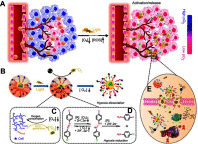Hypoxia-active nanoparticles used in tumor theranostic
- PMID: 31190820
- PMCID: PMC6535445
- DOI: 10.2147/IJN.S196959
Hypoxia-active nanoparticles used in tumor theranostic
Abstract
Hypoxia is a hallmark of malignant tumors and often correlates with increasing tumor aggressiveness and poor treatment outcomes. Therefore, early diagnosis and effective killing of hypoxic tumor cells are crucial for successful tumor control. There has been a surge of interdisciplinary research aimed at developing functional molecules and nanomaterials that can be used to noninvasively image and efficiently treat hypoxic tumors. These mainly include hypoxia-active nanoparticles, anti-hypoxia agents, and agents that target biomarkers of tumor hypoxia. Hypoxia-active nanoparticles have been intensively investigated and have demonstrated advanced effects on targeting tumor hypoxia. In this review, we present an overview of the reports published to date on hypoxia-activated prodrugs and their nanoparticle forms used in tumor-targeted therapy. Hypoxia-responsive nanoparticles are inactive during blood circulation and normal physiological conditions but are activated by hypoxia once they extravasate into the hypoxic tumor microenvironment. Their use can enhance the efficiency of tumor chemotherapy, radiotherapy, fluorescence and photoacoustic intensity, and other imaging and therapeutic strategies. By targeting the broad habitats of tumors, rather than tumor-specific receptors, this strategy has the potential to overcome the problem of tumor heterogeneity and could be used to design diagnostic and therapeutic nanoparticles for a broad range of solid tumors.
Keywords: bioreductive; metal complex; prodrug; tumor microenvironment.
Conflict of interest statement
The authors report no conflicts of interest in this work.
Figures




Similar articles
-
Stimuli-responsive nanoparticles for targeting the tumor microenvironment.J Control Release. 2015 Dec 10;219:205-214. doi: 10.1016/j.jconrel.2015.08.050. Epub 2015 Sep 1. J Control Release. 2015. PMID: 26341694 Free PMC article. Review.
-
Hypoxia-activated nanomedicines for effective cancer therapy.Eur J Med Chem. 2020 Jun 1;195:112274. doi: 10.1016/j.ejmech.2020.112274. Epub 2020 Mar 30. Eur J Med Chem. 2020. PMID: 32259703 Review.
-
Chemical Design and Synthesis of Functionalized Probes for Imaging and Treating Tumor Hypoxia.Chem Rev. 2017 May 10;117(9):6160-6224. doi: 10.1021/acs.chemrev.6b00525. Epub 2017 Apr 20. Chem Rev. 2017. PMID: 28426202 Review.
-
Hypoxia-directed and activated theranostic agent: Imaging and treatment of solid tumor.Biomaterials. 2016 Oct;104:119-28. doi: 10.1016/j.biomaterials.2016.07.010. Epub 2016 Jul 14. Biomaterials. 2016. PMID: 27449948
-
Hypoxia-Triggered Self-Assembly of Ultrasmall Iron Oxide Nanoparticles to Amplify the Imaging Signal of a Tumor.J Am Chem Soc. 2021 Feb 3;143(4):1846-1853. doi: 10.1021/jacs.0c10245. Epub 2021 Jan 4. J Am Chem Soc. 2021. PMID: 33397097
Cited by
-
Targeting Tumor Hypoxia with Nanoparticle-Based Therapies: Challenges, Opportunities, and Clinical Implications.Pharmaceuticals (Basel). 2024 Oct 18;17(10):1389. doi: 10.3390/ph17101389. Pharmaceuticals (Basel). 2024. PMID: 39459028 Free PMC article. Review.
-
Polymersomes as Innovative, Stimuli-Responsive Platforms for Cancer Therapy.Pharmaceutics. 2024 Mar 26;16(4):463. doi: 10.3390/pharmaceutics16040463. Pharmaceutics. 2024. PMID: 38675124 Free PMC article. Review.
-
Photodynamic therapy and associated targeting methods for treatment of brain cancer.Front Pharmacol. 2023 Sep 28;14:1250699. doi: 10.3389/fphar.2023.1250699. eCollection 2023. Front Pharmacol. 2023. PMID: 37841921 Free PMC article. Review.
-
Opportunities and Challenges of Nanoparticles in Digestive Tumours as Anti-Angiogenic Therapies.Front Oncol. 2022 Jan 10;11:789330. doi: 10.3389/fonc.2021.789330. eCollection 2021. Front Oncol. 2022. PMID: 35083147 Free PMC article. Review.
-
Tumor Microenvironment-Responsive Drug Delivery Based on Polymeric Micelles for Precision Cancer Therapy: Strategies and Prospects.Biomedicines. 2024 Feb 11;12(2):417. doi: 10.3390/biomedicines12020417. Biomedicines. 2024. PMID: 38398021 Free PMC article. Review.
References
Publication types
MeSH terms
Substances
LinkOut - more resources
Full Text Sources

